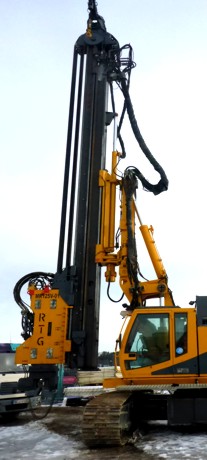Drilling Rig Inspections
We have a new website. Please visit mevas.net
Examination of Drill Rigs and Piling Machines
Drilling Rigs and Piling Machines are very complex and have very different features. For purchasing a machine it is not only necessary to find the machine for the right price. It is also essentially to find a machine with a reasonable condition. Not many engineers are qualified to look at the technical condition. Most engineers with drilling and piling machinery experience are more than busy. Why not asking Mevas for an inspection?
Inspection report for used civil-engineering machinery
Most people from normal machinery business do not understand civil-engineering machines. They do neither know what a kelly bar is nor do they know what a casing oscillator is or what a crowd cylinder is for. That is normal as most standard construction machinery is simpler than a drill rig or a piling machine. We do also know about trenching machines, side wall cutters and plastic concrete equipment.
Contact Mevas if you need inspection for a used Bauer, Casagrande, PMV, Soilmec, Junttan, Delmag, Banut, Menck, Liebherr, Sennebogen or ABI.
Inspection Reports for Civil-Engineering Equipment
We offer inspection for used civil-engineering equipment ans special heavy machinery such as pile drivers, drill rigs, desanding machines, vibrators, vibration hammers and leaders, diesel impact hammers, telescopic leaders, RTG equipment, grab systems, duty-cycle cranes and diaphragm wall grabs.
Our inspection reports are in English language. In case of interest
check out our
inspection checklist for drill rigs. The original inspection comes
with 100 photos and a video. Also a sample report for a
pile driver is available. The latest inspection form is more
sophisticated than the visible sample.
What is an drill rig for civil engineering and what are the major components of it?
A drill rig, also known as a drilling rig or drill machine, is a
specialized piece of heavy equipment used in civil engineering and
construction projects for drilling holes into the earth's surface. These
holes can serve various purposes, such as soil and rock sampling,
geotechnical investigations, foundation construction, piling, and the
installation of utilities like water wells and geothermal heat exchange
systems. Drill rigs come in different types and sizes, depending on the
specific drilling requirements. Here are the major components of a
typical drill rig for civil engineering:
1. •Mast or Derrick• The mast is the vertical tower or
frame that supports the drilling equipment and provides stability during
the drilling process. It can be a lattice-type structure or a solid
mast, depending on the type of drill rig.
2. •Drill String• The drill string is a series of
connected pipes, drill rods, or casings that extend from the drilling
rig down into the borehole. It includes:
- •Drill Bit• The drill bit is the cutting tool at the
end of the drill string that contacts the ground and creates the
borehole.
- •Drill Pipe• These are threaded sections of pipe that
connect the drill bit to the surface. They allow for the circulation of
drilling fluid and provide stability to the drill string.
- •Casing• In some cases, casings or protective tubes
are used to line the borehole to prevent cave-ins, maintain borehole
stability, and protect the surrounding environment.
3. •Drilling Fluid (Mud)• Drilling fluid, often
referred to as "mud," is a mixture of water and additives that serves
several purposes:
- •Lubrication• It lubricates the drill bit and helps
reduce friction.
- •Cooling• It cools down the drill bit and prevents
overheating.
- •Cleaning• It carries away drill cuttings and keeps
the borehole clear.
- •Stabilization• It provides stability to the borehole
and prevents collapses.
4. •Hoisting Equipment• This includes a winch or hoist
mechanism that raises and lowers the drill string and other equipment.
It is used to control the depth of the borehole.
5. •Rotary System• In many drill rigs, a rotary system
is used to rotate the drill string and drill bit. This system can be
powered by a hydraulic motor or an electric motor.
6. •Power Source• Drill rigs are powered by internal
combustion engines, hydraulic systems, or electric motors, depending on
the rig's design and intended use.
7. •Control Panel• The control panel allows the
operator to monitor and control various aspects of the drilling
operation, such as the drilling speed, depth, and rotation.
8. •Stabilizing Legs or Tracks• Some drill rigs have
stabilizing legs or tracks that can be extended to provide additional
stability, especially on uneven terrain.
9. •Operator's Cabin• Larger drill rigs may have an
enclosed operator's cabin with controls, instrumentation, and safety
features to protect the operator.
10. •Safety Features• Drill rigs are equipped with
various safety features, including emergency shutdown systems, guards,
and safety rails to protect the operator and personnel working around
the rig.
The choice of drill rig and its components depends on the specific
requirements of the civil engineering project, including factors like
the depth of drilling, soil or rock conditions, and accessibility to the
drilling site. Different types of drill rigs include rotary drilling
rigs, percussion drilling rigs, and auger drilling rigs, among others,
each suited for different applications.

